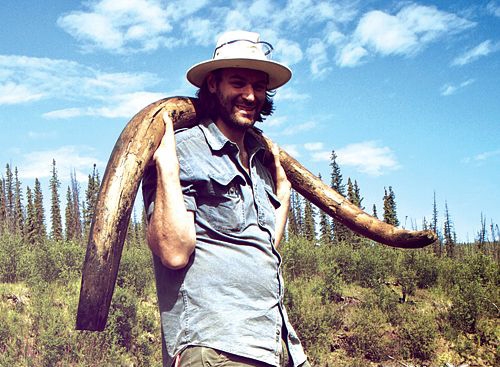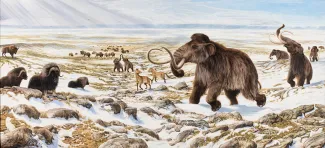For many people, the woolly mammoth is the prime example of an ice age mammal. These large, furry elephants were perfectly adapted to living on the Mammoth Steppe of ice age Yukon. About the size of an African elephant, a woolly mammoth stood a little over three metres tall at the shoulder and consumed more than 200 kilograms of grass each day.
The discoveries of complete frozen woolly mammoth carcasses have revealed detailed glimpses into the life and appearance of these iconic animals. Some preserved physical characteristics can even be linked back to specific adaptations to life in the cold — for example, thick fur, small ears and a short tail were all adaptations to minimize heat loss.
Woolly mammoths, like many giant animals of the Ice Age, went extinct as the climate warmed at the end of the last glacial period. Fossils from North America and Asia indicate woolly mammoths disappeared from the mainland around 12,000 years ago. Remarkably, they managed to survive on small Arctic islands off northern Siberia until around 4,000 years ago.
Yukon's Woolly Mammoth History

The long, curved tusks of woolly mammoths are probably the most immediately recognized ice age fossil from Yukon. A single tusk from an adult male can stretch over 3.5 metres long and weigh more than 100 kilograms. These tusks may have been used for display, defence, or possibly to sweep away snow to get at grass in the winter.
Tusks preserve a wealth of information about a mammoth's life because they are a lot like trees, with layer upon layer of growth rings forming over time. By studying these growth rings, scientists can learn about a mammoth's health through its entire lifespan, the climate it lived in, and where it migrated to and from.
Mammoth teeth, or molars, are common fossils in Yukon. These mammoth molars are very distinctive, with vertical hard enamel plates that formed a flat grinding surface for breaking down tough grasses. Analysis of mammoth baby molars from Old Crow, Yukon revealed that young mammoths may have nursed on their mothers' milk for much longer than today's African elephants—nursing almost exclusively until about three years of age. This prolonged nursing may have been an adaptation to help survive the long dark winters, when food was scarce. On the other hand, maybe young mammoths preferred to stay close to their mothers, so as to avoid falling prey to a hungry Beringian lion or other predator?
The first mammoths crossed Beringia into North America around 1 million years ago. DNA extracted from fossil bones reveals that the woolly mammoth evolved in Yukon and Alaska around 300,000 years ago from those ancestors. They eventually spread back across Beringia and into Europe. Woolly mammoths also had a close cousin, the larger-bodied Columbian mammoth (Mammuthus columbi), which lived further south in North America. Recent genetic evidence is suggesting that woolly and Columbian mammoths interbred in the regions where they overlapped.
Recent Discoveries
Thanks in part to the amazing preservational powers of permafrost, the North's natural deep freezer, geneticists have come tantalizingly close to resurrecting the woolly mammoth! We now know the complete sequence of mammoth DNA—their genome—including the DNA sequence for mammoth hair colour (not all mammoths were brunettes!) and blood proteins. But so far a living, breathing mammoth is still only possible in science fiction.
Want to keep exploring? Check out the Beringian Research Notes on the woolly mammoth.
Scientists have found evidence that like modern elephants, mammoths sometimes used their tusks as a "nose-rack" for resting their trunk.
They would use the right or left tusk depending on whether they were right- or left-"handed".

